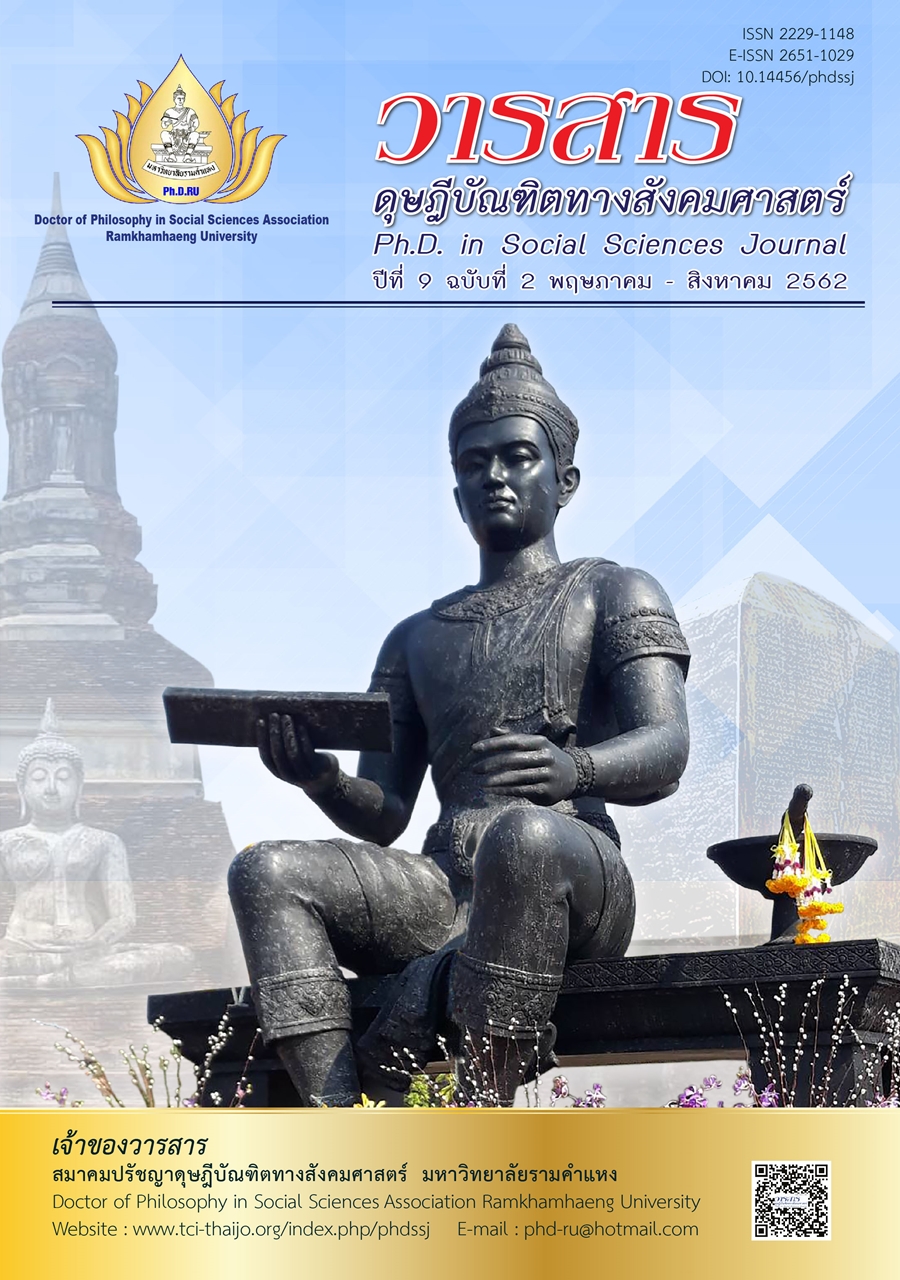Relationship Between Innovative Leadership, Effectiveness and Competitive Advantage: SMEs in Bangkok
Main Article Content
Abstract
This research aims to (1) to study the innovative leadership of the small and medium enterprises in Bangkok (2) to study the relationship between innovative leadership, effectiveness and competitive advantage of small and medium enterprises in Bangkok. Samples used in this study consists of Executives of small and medium enterprises, that is, the number of 420 kits. Structural equation analysis (Structural Equation Modeling (SEM)
The results of this research found that:
1. the components of innovative leadership consisted of (1) visionary and leading change, (2) creative thinking (3) teamwork and participation (4) ethics and (5) Innovative Organization. Creative thinking has a standardized regression coefficient of 2.21, teamwork and participation with a regression coefficient of 0.94, visionary and leading change with a coefficient of regression of 0.83, ethics with a regression coefficient of 0.74 and innovative organization had a coefficient of 0.72.
2. The relationship between innovative leadership, effectiveness and competitive advantage of small and medium enterprises in Bangkok. The results show that innovative leadership have a positive relationship with effectiveness. Effectiveness with a coefficient of 0.813. Innovative leadership is in the same direction as competitive advantage, with a coefficient of 0.305. Effectiveness is related in the same direction to the competitive advantage, with a coefficient of 0.326 at the significance level.
Article Details
Academic articles, research articles, and book reviews in the Ph.D. in Social Sciences Journal are author’s opinions, and not the publisher’s, and is not the responsibility of the Ph.D. in Social Sciences Journal Philosophy Association, Ramkhamhaeng University. (In the case that research is done on human, the researcher has to be trained in Ethics for Doing Research on Human Training and has to produce the evidence of the training).
References
Bass, B. M., & Avolio, B. J. (1997). Transformation leadership development: Manual for the multifactor leadership questionnaire. Pale Alto, CA: Mindgarden.
Best, J. W., & Kahn, J. V. (2003). Research in education (9th ed.). Boston: Allyn and Bacon.
Cronbach, L. J. (1974). Essentials of psychological testing (3rd ed.). New York: Harper and Row.
George, G., McGahan, A. M., & Prabhu, J. (2012). Innovation for inclusive growth: Towards a theoretical framework and a research agenda. Journal of Management Studies, 49(4), 661-683.
Hair, J., Black, W., Babin, B., Anderson, R., & Tatham, R. (2006). Multiveriate data analysis (6th ed.). Upper Saddle River, NJ: Pearson Prentice Hall.
Horth, D. M., & Vehar, J. (2012). Becoming a leader who fosters innovation. Singapore: Center for Creative Leadership.
Howell, J. M., & Shamir, B. (2005). The role of followers in the charismatic leadership process: Relationships and their consequences. Academy of Management Review, 30(1), 96-112.
Jong, J. P., & Den Hartog, D. N. (2007). How leaders influence employees’ innovative behaviour. European Journal of Innovation Management, 10(1), 41-64.
Leonidas, C. L., Thomas, A. F., Paul, C., Stavroula, S., & Constantine, S. K. (2015). Environmentally friendly export business strategy: Its determinants and effects on competitive advantage and performance. International Business Review, 24, 798-811.
Maina, M. (2012). Total quality operations effectiveness and competitive advantage in horticultural industry in Kenya. Retrieved from http://erepo.usiu.ac.ke/bitstream/handle/11732/1528/Muchara_PHD.pdf?sequence=4&isAllowed=y
Mekvichai, B. ( 2011). Urban development policy. Bangkok: Urban Green Development Institute. [In Thai]
Michael, D. M., Erin, M. T., Cory, H., & Tristan, M. (2017). Cognitive skills and leadership performance: The nine critical skills. The Leadership Quarterly, 28(1) 24-39.
Ministry of Information and Communication Technology. (2016). Digital development plan for economy and society. Retrieved from http://www.mict.go.th/assets/portals/1/files/590613_4Digital_Economy_Plan-Book.pdf [In Thai]
National Innovation Agency. (2004). Innovation management for executives. Bangkok: Ministry of Science and Technology. [In Thai]
Porter, M. E. (1985). Competitive advantage: Creating and sustaining superior performance. New York: The Free Press.
Punthai, B. (2014). Introduction to educational research methodology (3th ed.). Bangkok: Ramkhamkaeng University Press. [In Thai]
Sooksan, K., & Gayle, C. A. (2010). The power of vision: Statements that resonate. Journal of Business Strategy, 31(1), 37-45.
Sydänmaanlakka, P. (2003). Intelligent leadership and leadership competencies: Developing a leadership framework for intelligent organizations. Retrieved from https://aaltodoc.aalto.fi/handle/123456789/2042
Thongrawd, C. (2007). SME leadership in a situation of economic crisis and the survival of SME industrial. Journal of the Association of Researchers, 12(2), 106-112. [In Thai]
Vanichbuncha, K. (2010). Using SPSS for windows for data analysis (16th ed.). Bangkok: Thammasarn. [In Thai]


